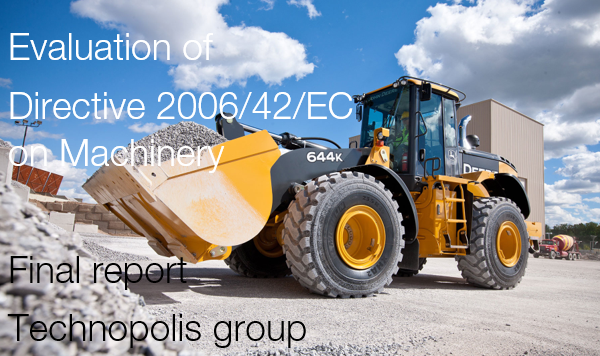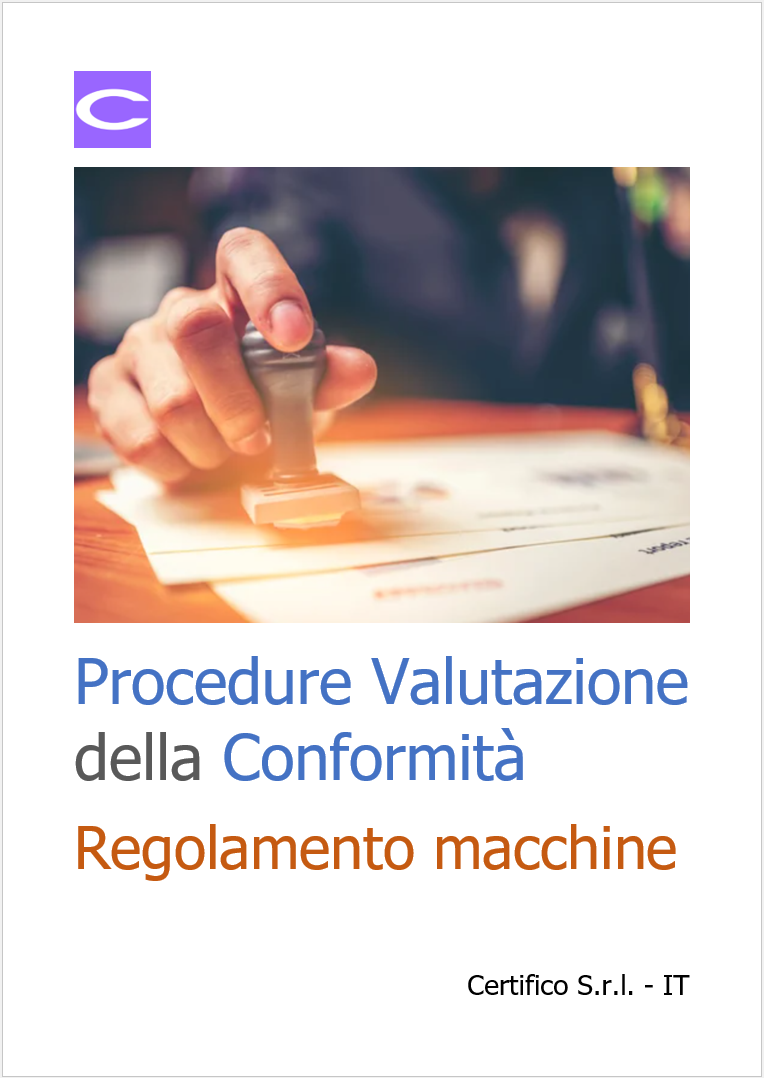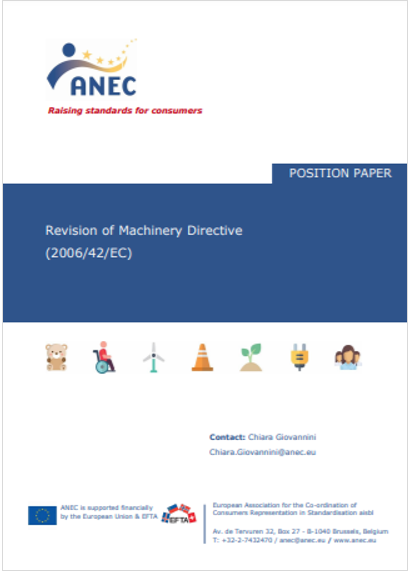Informazione tecnica HSE / 25 ° anno
/ Documenti disponibili:
45.530
/ Documenti scaricati: 34.329.127
/ Documenti scaricati: 34.329.127

30.09.2017 Technopolis group - Final report
This report presents the Evaluation of Directive 2006/42/EC on Machinery. It was commissioned by EC Directorate-General for Internal Market, Industry, Entrepreneurship and SMEs (DG GROW), and undertaken by a consortium led by Technopolis Group over an 18-month period during 2016-2017.
The findings and conclusions are based on a programme of research and analyses, which included a public consultation, a series of targeted consultation surveys, a programme of interviews, a review of relevant documentation and an analysis of statistical databases and reports.
Scope of the evaluation
The focus of the evaluation is the 2006 Machinery Directive (MD), which is concerned with the free movement of machinery within the EU internal market, and with ensuring health safety of users of machinery. It is in fact the latest revision to a much earlier Directive (89/392/EEC) adopted in 1989.
The purpose of the evaluation is to review the performance of the Directive and to determine the extent to which it is fit for purpose, providing evidence and conclusions that might form the basis for possible future legislative initiatives. In particular, the study is asked to assess the extent to which the Directive has met its twin objectives of (i) guaranteeing the free movement of relevant machinery within the Single Market, and (ii) ensuring a high level of safety and protection for machinery users (workers and consumers). To this end, the aims were to assess the relevance, effectiveness, coherence, efficiency and EU added value of the Directive, by addressing 18 specific evaluation questions. The evaluation covers the functioning of the Directive, including the processes involved in transposing, implementing and enforcing it. It covers all relevant product categories and 33 countries (EU28, EFTA and Turkey) and focuses on the period from 2010 (after the deadline for application of the MD).
Relevance of the Directive
The two objectives of the Directive – facilitating free movement of machinery and ensuring health and safety – remain entirely relevant to market needs (manufacturers and users). The machinery sector continues to be an important part of the EU economy 30 years after the adoption of the original Directive, accounting for 4% of all manufacturing businesses, 9% of all manufacturing production (value) and 10% of employment in the manufacturing sector. Its importance in terms of trade is also significant, with machinery accounting for nearly one-quarter of the value of all EU exports in 2015, and 60% of this trade occurring between Member States.
Facilitating the free movement of machinery is therefore a significant EU-wide concern. The great majority of stakeholders consulted for the study also agree that ensuring free movement of machinery is a very important objective, providing a strong indication that this is of high relevance to the needs and concerns of EU stakeholders, with widespread relevance both to the machinery market and amongst users. The vast majority also agreed that the Directive (at least in its concept and intentions) is an entirely appropriate response to the aim of ensuring free movement of machinery.
In relation to ensuring health and safety, despite a downward trend in the number of accidents at work (both in terms of absolute numbers and per 100,000 employees), there were still over 3 million nonfatal accidents and nearly 3,700 fatal accidents in EU workplaces in 2013 (all sectors). This implies that on average most people will have an accident at work during their lifetime causing more than three days of absence, or death, making this a significant and widespread issue. There are sizeable financial and other (social) costs of these accidents (e.g. productivity loss, healthcare, reduced quality of life, administration), which have been calculated in different countries as equating to 1-5% of GDP annually. Importantly, those sectors and occupations that are most relevant to machinery (and the Directive) tend to have some of the highest rates of injuries (e.g. the Manufacturing, Construction and Agriculture sectors combined accounted for 51% and 38% of all fatal and non-fatal accidents respectively in 2013), making this an even more pressing issue for this sector. Nearly all stakeholders consulted through the study placed great importance on ensuring a high level of health and safety for users of machinery, providing a strong indication that this objective is of high relevance to the needs and concerns of EU stakeholders. The majority also felt that the Directive (its scope and provisions) was an ‘entirely appropriate’ response to addressing this aim.
The Directive has maintained its relevance, despite changes in technology and the business environment. It has undergone several iterations since 1989, adding or revising elements, including in its scope and requirements. However, these changes have been to improve clarity, adjust coverage of pre-existing machinery (and address associated risks), or reflect changes in the perceived relevance/ importance of certain aspects of health and safety. They have not come about as a reaction to shifts in technology or the market. This is unsurprising, given that New Approach Directives (including the MD) are limited to essential requirements (“principles”), while the state of technology (state of the art) is then determined by stakeholders through technical specifications. As such, the majority view of stakeholders is that the MD copes well with change. Having said this, a significant minority of those consulted have highlighted that specific new innovations may test the suitability of the Directive and reduce its effectiveness going forward. This includes innovations in the areas of digitisation, robotics, software and autonomous control, as well as the increasing prevalence of etrade, fulfilment houses and (un-checked) non-compliance of products from third countries.
Most stakeholders believe the rate and extent of innovation in the machinery sector has increased over the past decade, but the link between this and the Machinery Directive (specifically) is less clear. This is because the Directive has acted as both an enabler and barrier to innovation in the sector: positively influencing innovation through the facilitation of trade, support for technology transfer and encouragement of innovative safety features, tools and techniques; while at the same time reducing the rate of innovation by adding to the cost or complexity of introducing new technology.
...
Table of Contents
Executive Summary
1 Introduction
2 Background to the Machinery Directive
2.1 Origins, rationale and objectives of the Directive
2.2 Summary of the main provisions of the Directive
2.3 Transposition and implementation of the Directive
2.4 Defining the intervention logic for the Machinery Directive
3 Evaluation requirements and questions
4 Overview of research approach and methodology
4.1 Main phases of the evaluation
4.2 Principle research methods and sources of evidence
4.3 Summary of consultation numbers
4.4 Limitations for the analysis
5 Answers to the evaluation questions
5.1 Evaluation Question 1: the current size and structure of the market / sector
5.2 Evaluation Question 2: correspondence between objectives and current needs
5.3 Evaluation Question 3: The extent to which the Directive deals with innovation
5.4 Evaluation Question 4: discrepancies in interpretation of requirements
5.5 Evaluation Question 5: the extent to which the Directive has contributed to objectives
5.6 Evaluation Question 6/7: the effectiveness of conformity assessment options
5.7 Evaluation Question 8: the effectiveness of European harmonised standards
5.8 Evaluation Question 9: the effectiveness of mechanisms relating to non-compliance
5.9 Evaluation Questions 10/11: enablers and barriers to effectiveness
5.10 Evaluation Question 12: the costs involved as a result of the Directive
5.11 Evaluation Question 13: the benefits realised as a result of the Directive
5.12 Evaluation Question 14: the extent to which costs are reasonable and proportionate
5.13 Evaluation Questions 15 & 16: potential for simplification and reduced inefficiency
5.14 Evaluation Question 17: coherence and complementarity of the Directive
5.15 Evaluation Question 18: added value of a European directive
6 Conclusions
6.1 Context of the Directive
6.2 Relevance of the Directive
6.3 Effectiveness of the Directive
6.4 Efficiency of the Directive
6.5 Coherence of the Directive
6.6 European Added Value of the Directive
Appendices
Appendix A Methodology
A.1 Evaluation approach
A.2 Conduct of the evaluation
A.3 Principle evaluation methods and sources
A.4 Limitations and mitigation measures
Appendix B Stakeholder consultation
B.1 Consultation strategy and process
B.2 Consultation responses
B.3 Targeted consultation questionnaires
B.4 Survey consultation results
Appendix C Additional data
C.1 Distribution of published EN by technical body
C.2 Suggested gaps in the Harmonised Standards portfolio
C.3 Mapping of actions (and costs) triggered by the Machinery Directive
C.4 Price deflation calculations
Fonte: Commissione Europea
Collegati:

ID 19785 | Rev. 2.0 del 04.07.2023 / Documento completo in allegato
Il presente documento illustra le novelle disposizioni in merito ...

Applicazione del concetto di "Stato dell'Arte" alla Direttiva macchine con riferimenti.
Con la Guida alla Direttiva macchine 2006/42/CE Ed. 2.1 Luglio 2017, si precis...

ANEC, May 2020
This position paper expresses ANEC’s preliminary views on the revision of the Machinery Directive (2006/42/EC). For ease...
Testata editoriale iscritta al n. 22/2024 del registro periodici della cancelleria del Tribunale di Perugia in data 19.11.2024